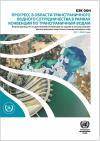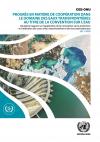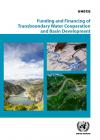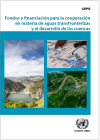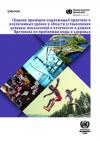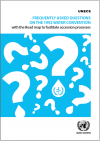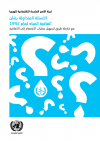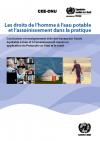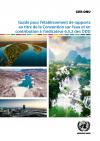Publications
Displaying Results 41 - 60 of 537
- Pусский
The Convention on the Protection and Use of Transboundary Watercourses and International Lakes (Water Convention), hosted by the United Nations Economic Commission for Europe (ECE), requires Parties to prevent, control and reduce transboundary impact, use transboundary waters in a reasonable and equitable way and cooperate to ensure their sustainable management. Parties bordering the same
- Français
La Convention sur la protection et l’utilisation des cours d’eau transfrontières et des lacs internationaux (Convention sur l’eau), dont le secrétariat est assuré par la Commission économique des Nations Unies pour l’Europe (CEE-ONU), exige des Parties qu’elles préviennent, maîtrisent et réduisent l’impact transfrontière, qu’elles utilisent les eaux transfrontières de manière raisonnable et
- English
More than 60 per cent of the world’s freshwater flow is shared between two or more riparian states. The sustainable and cooperative management of these transboundary water resources is crucial for access to water, sustainable development as well as regional stability and peace. However, many countries and basins struggle to identify and mobilize the needed funding for transboundary water
- Español
More than 60 per cent of the world’s freshwater flow is shared between two or more riparian states. The sustainable and cooperative management of these transboundary water resources is crucial for access to water, sustainable development as well as regional stability and peace. However, many countries and basins struggle to identify and mobilize the needed funding for transboundary water
- English
Most of the world’s water resources are shared between countries. These transboundary waters create social, economic, environmental and political interdependencies that make cooperation a precondition to sustainable development and peace. SDG indicator 6.5.2 measures cooperation on both transboundary river and lake basins, and transboundary aquifers. In this second report on SDG indicator 6.5.2,
- العربية
Most of the world’s water resources are shared between countries. These transboundary waters create social, economic, environmental and political interdependencies that make cooperation a precondition to sustainable development and peace. SDG indicator 6.5.2 measures cooperation on both transboundary river and lake basins, and transboundary aquifers. In this second report on SDG indicator 6.5.2,
- Pусский
Most of the world’s water resources are shared between countries. These transboundary waters create social, economic, environmental and political interdependencies that make cooperation a precondition to sustainable development and peace. SDG indicator 6.5.2 measures cooperation on both transboundary river and lake basins, and transboundary aquifers. In this second report on SDG indicator 6.5.2,
- Français
La majorité des ressources mondiales en eau sont partagées entre les pays. Ces eaux transfrontières créent des interdépendances sociales, économiques, environnementales et politiques qui font de la coopération une condition préalable au développement durable et à la consolidation de la paix. L’indicateur 6.5.2 des ODD mesure la coopération relative aux bassins hydrographiques et aux aquifères
- Español
La mayoría de los recursos hídricos del mundo son compartidos entre varios países. Las aguas transfronterizas generan interdependencias políticas, sociales, económicas y ambientales que hacen de la cooperación en materia de aguas transfronterizas una condición previa para el desarrollo sostenible y la paz. Mediante el indicador 6.5.2 de los ODS se mide la cooperación transfronteriza tanto en las
- Pусский
The objective of the Collection of good practices and lessons learned on target setting and reporting under the Protocol on Water and Health is to provide concrete advice to countries planning to embark on the process of setting, revising or implementing targets, and reporting on the progress achieved in accordance with the Protocol.
In 2010,
- Pусский
Конвенция по охране и использованию трансграничных водотоков и международных озер (Конвенция по трансграничным водам) была принята в 1992 году и вступила в силу в 1996 году. В 2003 году в Конвенцию по трансграничным водам, изначально разработанную в качестве регионального документа, были внесены поправки, с тем чтобы дать возможность странам, не входящим в регион ЕЭК ООН, присоединяться к
- Français
La Convention sur la protection et l’utilisation des cours d’eau transfrontières et des lacs internationaux (Convention sur l’eau) a été adoptée en 1992, et est entrée en vigueur en 1996. Conçue comme un instrument régional, la Convention sur l’eau a été modifiée en 2003 pour permettre l’adhésion des pays hors de la région de la CEE-ONU. Depuis 2016, tous les États membres de l’ONU peuvent
- English
The Convention on the Protection and Use of Transboundary Watercourses and International Lakes (Water Convention) was adopted in 1992 and entered into force in 1996. Designed as a regional instrument, the Water Convention was amended in 2003 to allow accession by countries outside the UNECE region. As of 2016, all United Nations Member States can accede to the Water Convention. As at mid-2020,
- العربية
تم اعتماد اتفاقية حماية واستخدام المجاري المائية والبحيرات الدولية )اتفاقية المياه( عام
1992 ، ودخلت هذه الاتفاقية حيّز النفاذ عام 1996 . وقد عُدِّلت اتفاقية المياه، التي صُمِّمت في
الأساس كأداة إقليمية، عام 2003 للسماح بانضمام بلدان من خارج منطقة لجنة الأمم المتحدة
الاقتصادية لأوروبا. واعتباراً من عام 2016 ، أصبح باستطاعة جميع الدول الأعضاء في الأمم
المتحدة الانضمام إلى اتفاقية المياه. وبحلول
- English
This policy brief highlights the main results of an assessment of the water-food-energy-ecosystems nexus in the North-Western Sahara Aquifer System (NWSAS), shared by Algeria, Libya and Tunisia. The aquifer system is one of the largest transboundary groundwater reserves of North Africa, extending over one million square kilometres and subject to increased water demands. Improving the
- English
This report highlights the main results of an assessment of the water-food-energy-ecosystems nexus in the North-Western Sahara Aquifer System (NWSAS), shared by Algeria, Libya and Tunisia. The aquifer system is one of the largest transboundary groundwater reserves of North Africa, extending over one million square kilometers and subject to increased water demands. Improving the management of the
- Pусский
Протокол по проблемам воды и здоровья является юридически обязательным документом, направленным на обеспечение адекватного снабжения безопасной питьевой водой и санитарией для всех, а также эффективной охраны водных ресурсов в панъевропейском регионе. При реализации этих целей особое внимание уделяется обеспечению равного доступа к услугам водоснабжения и санитарии «всем членам общества, особенно
- Français
Le Protocole sur l’eau et la santé est un instrument juridiquement contraignant qui a pour objet d’assurer à tous un approvisionnement suffisant en eau potable salubre et en assainissement, et, de protéger efficacement les ressources en eau dans la région pan-européenne. Dans la poursuite de ces objectifs, il accorde une attention particulière à garantir un accès équitable aux services d’eau et d
- English
There is an increasing recognition that energy-related objectives can be achieved more effectively through integrated and consultative planning, in synergy with environmental and other sectoral objectives, notably those of the water and agricultural sectors. A series of intersectoral “nexus” assessments under the Convention on the Protection and Use of
- Français
L’introduction d’un mécanisme de suivi par le biais d’établissement de rapports au titre de la Convention sur l’eau et dans le cadre de l’adoption du cadre des ODD (indicateur 6.5.2 des ODD) marque une étape importante dans le soutien à la coopération transfrontière sur l’eau. Le présent Guide pour l’établissement de rapports au titre de la Convention sur l’eau et en contribution à l’indicateur 6


